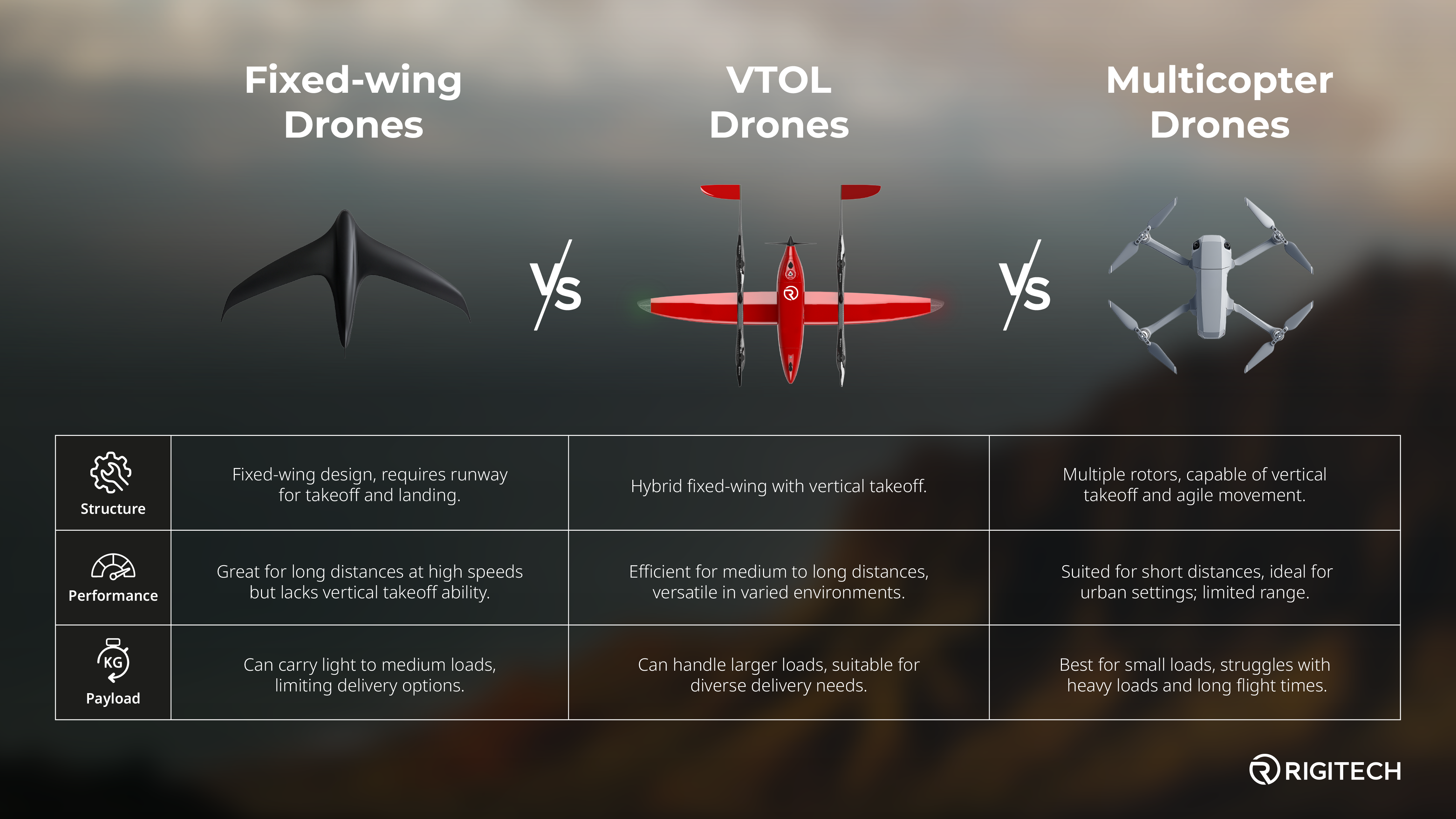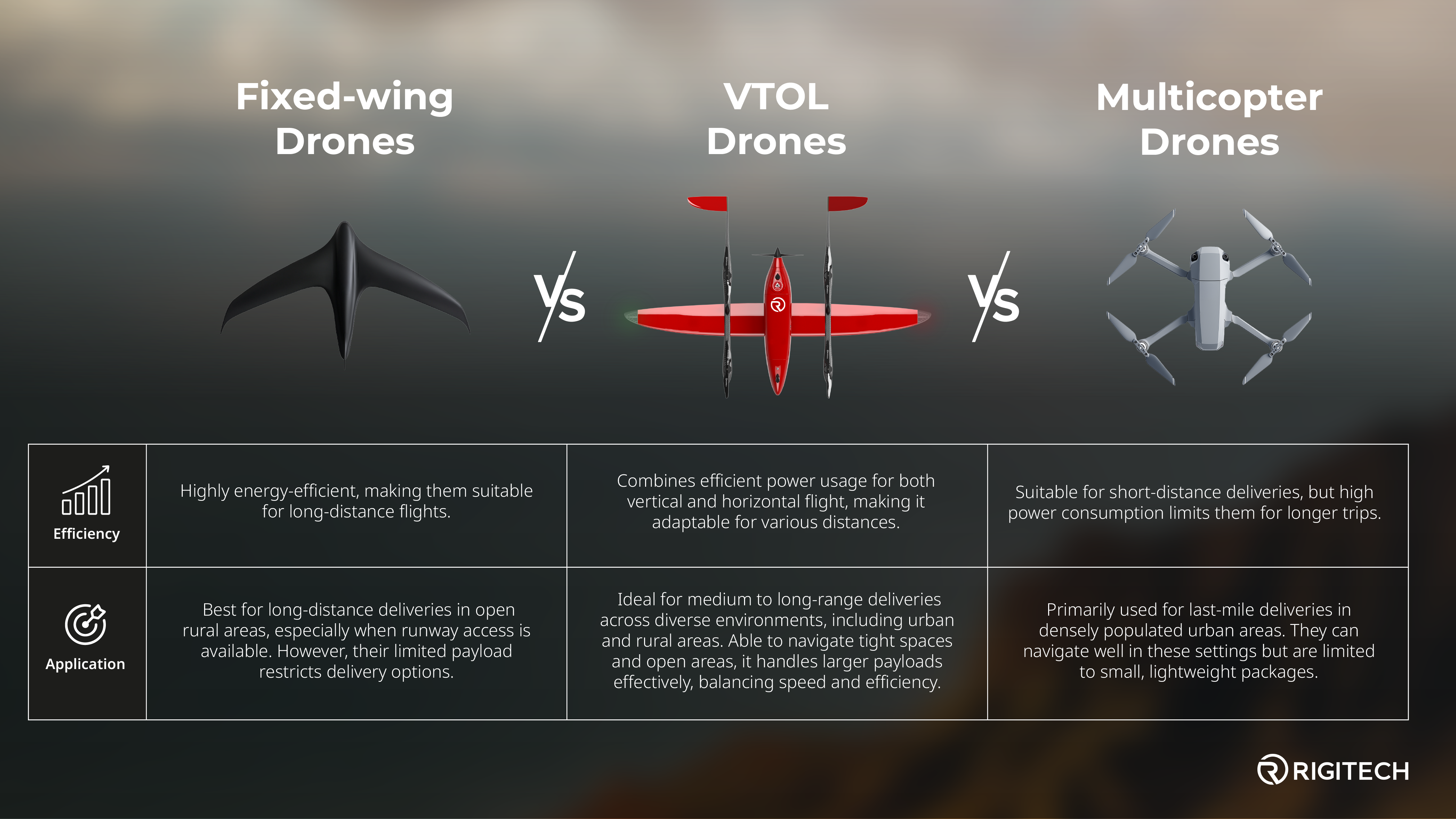In drone delivery, fixed-wing drones, multicopters (quadcopters), and Vertical Take-Off and Landing (VTOL) drones each present unique advantages and limitations. While fixed-wing drones excel in distance, quadcopters are known for agility, and VTOL drones like the Eiger combine the best of both for a balanced, versatile solution. This guide will help clarify the distinctions and potential applications for each type, especially in the context of delivery.

Design and Capabilities
Fixed-Wing Drones
Structure: Fixed-wing drones are designed like conventional aircraft and require a runway for takeoff and landing.
Performance: They excel at covering long distances at high speeds but their inability to take off and land vertically limits their operational flexibility.
Payload: Can handle light to medium loads, but this can restrict the types of deliveries possible.
Multicopters (Quadcopters)
Structure: Quadcopters are equipped with multiple rotors. Capable of vertical take-off, hovering, and agile maneuverability.
Performance: Excellent over short distances, making them ideal for urban environments, but limited range makes them less practical for long-distances delivery routes.
Payload: Ideal for small, light loads but quadcopters struggle with heavy loads and long flight times.
VTOL Drones (Eiger)
Structure: This VTOL design features a hybrid structure that combines the efficiency of a fixed-wing a vertical takeoff and landing capabilities.
Performance: Optimized for medium to long-distance deliveries, it offers the efficiency of fixed-wing flight while retaining the flexibility needed for a variety of environments.
Payload: Capable of handling larger payloads, this drone effectively meets diverse delivery needs in a variety of scenarios.

Efficiency and Application
Fixed-Wing Drones
Efficiency: These drones maximize energy efficiency during long flights, making them ideal for extended distances.
Application: Ideal for long distance deliveries where runway access is available, and is effective in open rural areas with few obstructions. However, their low payload capacity limits delivery options.
Multicopters (Quadcopters)
Efficiency: Suitable short-distance deliveries, their high power consumption limits flight range and efficiency for longer deliveries.
Application: Best suited for last-mile deliveries in densely populated urban environments, they can effectively navigate urban landscapes, but their suitability is primarily limited to very small, lightweight packages, limiting operational versatility.
VTOL Drones
Efficiency: This advanced VTOL drone optimizes power usage for both vertical lift and horizontal travel, making it efficient for deliveries over varying distances.
Application: Ideal for medium to long-range deliveries that require adaptability and efficiency in various environments, this drone can operate effectively in both urban and rural areas. It is capable of navigating confined spaces while also handling larger open areas. Additionally, with the ability to manage larger payloads, it meets diverse delivery needs without sacrificing speed or efficiency.
Conclusion
In summary, while fixed-wing drones and multicopters serve specific niche in the delivery market, the advanced VTOL design are clearly emerging as the best solution for a variety of applications:
- Fixed-Wing: Best for long-distance efficiency but lacks operational versatility.
- Multicopters: Effective for short-range agility but limited in payload capacity.
- VTOL Drones: Combining range, payload capacity, and operational flexibility, this drone is the most versatile and efficient choice for a broad spectrum of delivery demands.
This VTOL model represents the future of drone delivery, offering performance and adaptability that positions it ahead in a competitive landscape. Understanding these differences can help in selecting the right drone for your delivery needs. Learn more about how we designed our fixed-wing VTOL Eiger drone for maximum efficiency in long-distance deliveries.


